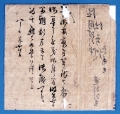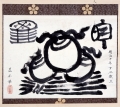( Maeda ) 27 found.
| Title | |
|---|---|
 |
Daijoji Temple Sites |
| Daijoji Temple was originally built by Iehisa Togashi in Oshinosho as an esoteric Buddhist temple, meant to be headed by the monk Chokai. Later, Iehisa and Chokai invited Gikai Tettsu from Eiheiji Temple to head Daijoji Temple, and in 1293 Daijoji... | |
 |
Oshino |
| The name Oshino derives from Oshino-sho, a Kamakura-era (1185-1333) manor. The area included Oshikoshi, the northern Hon-machi section of Nonoichi City, and the Youkaichi, Yokogawa, and Hisayasu sections of Kanazawa City. When the Kaga Ikko-Ikki ... | |
 |
Nagaike Mura Muragoin |
| Toshitsune Maeda, 3rd lord of the Kaga Domain, implemented large reforms in agricultural administration. Prior to these reforms, crop yield (kokudaka) was confirmed by official land survey (kenchi) and tax (men) was levied. However, along with the... | |
 |
A Letter from Toshinaga Maeda |
| Toshinaga Maeda was born in 1562, the first son of Toshiie Maeda. After the Battle of Sekigahara in 1600, Toshinaga established Kaga Domain, which covered an extremely large area through the integration of Kaga, Ecchu, and Noto Provinces. This let... | |
 |
A Letter from Toshitsune Maeda |
| Toshitsune Maeda was the fourth son of Toshiie Maeda, founder of Kaga Domain. When the feudal lord Toshinaga Maeda retired in 1605, Toshitsune succeeded him. Toshitsune made a major contribution to flood control and agriculture. He also encourage... | |
 |
Kosho Hachiman Shrine |
| Kosho Hachiman Shrine was named in 1871 with a sacred object and main shrine located at Kanaya Palace (currently Oyama Shrine). These were granted to Tokumoto Town by feudal lord Nariyasu Maeda. It is surprising that the feudal lord would have gra... | |
 |
Cultural Properties at Kosho Hachiman Shrine |
| Kosho Hachiman Shrine houses documents that explain the process of giving Hachiman Shrine at Kanaya Palace to Tokumoto Village in 1871, historical documents related to Hachiman Shrine, and documents and drawings by Nariyasu Maeda. Among those docu... | |
 |
Tokumoto Mura Kimoiri Shihei Gansho (Request by Shihei, Tokumoto Village Organizer) |
| In 1871, because Hakusan Shrine in Tokumoto Village lacked a sacred object, Tokumoto resident Shihei asked Nariyasu Maeda, the 12th lord of Kaga Domain, for something he had written or touched as a sacred object for their shrine. This is the lette... | |
 |
Risei Todori Seo Magozo Gansho |
| The Notification issued by District Official Magozo Seo records Tokumoto Village's donation of money for feudal lord Nariyasu Maeda's move to Tokyo in September 1871. Other remaining documents include letters from Magozo Seo and Jikichi Kenbe. | |
 |
Seo Magozo Shojo |
| The Notification issued by District Official Magozo Seo records Tokumoto Village's donation of money for feudal lord Nariyasu Maeda's move to Tokyo in September 1871. Other remaining documents include letters from Magozo Seo and Jikichi Kenbe. | |
 |
Moto-gojukyoyo Bengata Shojo |
| The Notification issued by District Official Magozo Seo records Tokumoto Village's donation of money for feudal lord Nariyasu Maeda's move to Tokyo in September 1871. Other remaining documents include letters from Magozo Seo and Jikichi Kenbe. | |
 |
Kenbe Jikichi Shojo(1) |
| The Notification issued by District Official Magozo Seo records Tokumoto Village's donation of money for feudal lord Nariyasu Maeda's move to Tokyo in September 1871. Other remaining documents include letters from Magozo Seo and Jikichi Kenbe. | |
 |
Kenbe Jikichi Shojo(2) |
| The Notification issued by District Official Magozo Seo records Tokumoto Village's donation of money for feudal lord Nariyasu Maeda's move to Tokyo in September 1871. Other remaining documents include letters from Magozo Seo and Jikichi Kenbe. | |
 |
Uji Jinja Jinja Go Negai |
| A Request to Rename the Shrine was submitted in October 1874. The Letter from Hajime Tada was written to residents of the village informing them that the feudal lord Nariyasu Maeda was very pleased that they had donated 2 yen to him in return for ... | |
 |
Maedake Kafudai Tada Hajime Shojo |
| A Request to Rename the Shrine was submitted in October 1874. The Letter from Hajime Tada was written to residents of the village informing them that the feudal lord Nariyasu Maeda was very pleased that they had donated 2 yen to him in return for ... | |
 |
Kosyozan Hachimangu |
| Hachiman Shrine at Kanaya Palace enshrined the spirit of the deity of Ana-hachiman Shrine (Shinjuku, Tokyo), which was quite well known during the Edo Period (1603-1868). It is possible that Toshitsune Maeda, the 3rd feudal lord of Kaga Domain, wa... | |
 |
Hachiman Okami no Shingogaku |
| The framed name of the Hachiman God was displayed at Hachiman Shrine at Kanaya Palace. On the back of the frame, there is the engraved description of being written by Nariyasu Maeda in 1870. On the box in which this frame was stored, it is written... | |
 |
Hachiman Okami no Shingojiku |
| The framed name of the Hachiman God was displayed at Hachiman Shrine at Kanaya Palace. On the back of the frame, there is the engraved description of being written by Nariyasu Maeda in 1870. On the box in which this frame was stored, it is written... | |
 |
Kame no Ji |
| Kame no Ji was drawn by Nariyasu Maeda when he was 5 years old, and Saru no E was drawn by him when he was 7 years old. Takara no Tama no Zu was drawn by him in 1877. The back of the top of the box shows that this was housed at Kosho Hachiman Shri... | |
 |
Takara no Tama no Zu |
| Kame no Ji was drawn by Nariyasu Maeda when he was 5 years old, and Saru no E was drawn by him when he was 7 years old. Takara no Tama no Zu was drawn by him in 1877. The back of the top of the box shows that this was housed at Kosho Hachiman Shri... | |
 |
Saru no E |
| Kame no Ji was drawn by Nariyasu Maeda when he was 5 years old, and Saru no E was drawn by him when he was 7 years old. Takara no Tama no Zu was drawn by him in 1877. The back of the top of the box shows that this was housed at Kosho Hachiman Shri... | |
 |
Ogimen |
| Kame no Ji was drawn by Nariyasu Maeda when he was 5 years old, and Saru no E was drawn by him when he was 7 years old. Takara no Tama no Zu was drawn by him in 1877. The back of the top of the box shows that this was housed at Kosho Hachiman Shri... | |
 |
Yaso Yuka Ono-ono Onozukara Kobashi |
| Kame no Ji was drawn by Nariyasu Maeda when he was 5 years old, and Saru no E was drawn by him when he was 7 years old. Takara no Tama no Zu was drawn by him in 1877. The back of the top of the box shows that this was housed at Kosho Hachiman Shri... | |
 |
Tori-I |
| The Tomuro stone gate was moved to Tokumoto Village at the same time Hachiman Shrine at Kanaya Palace was moved. It is partially broken. "September 1863" is engraved on one of the gate's pillars. The other pillar shows that Tomoko, wife ... | |
 |
Sanja no Dai Gaku |
| The Tomuro stone gate was moved to Tokumoto Village at the same time Hachiman Shrine at Kanaya Palace was moved. It is partially broken. "September 1863" is engraved on one of the gate's pillars. The other pillar shows that Tomoko, wife ... | |
 |
Tanoshiri |
| The village name, Tanoshiri, appeared in a letter sent by Toshiie Maeda to his vassal Hikozo Fuwa in 1599. Tanoshiri Village was merged into Nonoichi Town in 1956. Go Community Center to the north of Tanoshiri Town was built in 1957. The statue o... | |
 |
Kiyokane |
| The name of Kiyokane Village appeared in a letter to a vassal written by the feudal lord Toshiie Maeda in 1599. This area was known for its watermelon production in the Showa Period (1926-1989). The legend of the God of Stone has been passed down... |